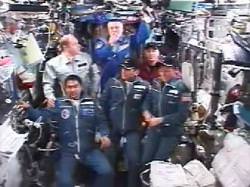October 5, 2007
A half-century ago the Russian satellite Sputnik 1 launched the world into an international space race (see a photo of Sputnik).
Today a new era of competition to break through the planet's atmosphere has begun, sparking visions of what human space travel will look like 50 years in the future. (See
photos of what space travel might look like over the next 50 years.)
The governments of the United States, India, China, and Japan have each announced high-profile plans to send humans back to the moon for the first time since Apollo 17 landed there in 1972.
Some of these projects involve building permanent lunar settlements that will serve as science stations as well as testing grounds for technology to send pioneering astronauts to Mars.
And renewed interest in space travel has already laid the foundations for a multibillion-U.S.-dollar entertainment and tourism industry, said Peter Diamandis, chair and CEO of the X Prize Foundation.
Historians of the future might call it the second space race—although this time the competition will be among private entrepreneurs as well as government agencies.
The next generations of rockets and shuttles along with tourist-friendly spaceports across the globe could eventually make space vacations as routine as a trip to Disneyland.
NASCAR in Space
For example, Diamandis will soon wave the starting flag for his latest venture, the Rocket Racing League.
This NASCAR-like competition features rocket-powered jets that resemble the podracers in the Stars Wars prequel The Phantom Menace.
The racers will be piloted by real people flying along preset courses plotted by computers, and online spectators will also have the option to add virtual rockets to the event.
"Fans playing on the Internet will be able to compete [against the] real rockets," Diamandis said.
The league's co-founder, Granger Whitelaw, said the first generation of these so-called X Racers will hug the surface of the planet in rallies slated to start in 2008. Seven years later a new generation of racers will speed through suborbital arcs into space.
And by 2025, Whitelaw said, the futuristic race will circumnavigate the Earth.
Lifting off from a New Mexico spaceport, the space-racers will "rocket through the atmosphere into low Earth orbit, circle the Earth, [and] execute a high-speed re-entry to the applause and awe of tens, if not hundreds, of millions of spectators worldwide."
In addition to this literal space race, the X Prize Foundation is offering prizes to spark independent human exploration of the moon.
A new Google Lunar X Prize will award 30 million U.S. dollars for the first privately designed robotic rover to land on the moon and beam video and other data back to Earth.
"There will be a range of X Prizes over the next 50 years, each pushing us further and challenging greater human exploration and endeavors," Diamandis said.
"I can imagine X Prizes for humans on the moon, capturing and returning asteroids, and discovering life on distant worlds."
And by 2025, Whitelaw said, the futuristic race will circumnavigate the Earth.
Lifting off from a New Mexico spaceport, the space-racers will "rocket through the atmosphere into low Earth orbit, circle the Earth, [and] execute a high-speed re-entry to the applause and awe of tens, if not hundreds, of millions of spectators worldwide."
In addition to this literal space race, the X Prize Foundation is offering prizes to spark independent human exploration of the moon.
A new Google Lunar X Prize will award 30 million U.S. dollars for the first privately designed robotic rover to land on the moon and beam video and other data back to Earth.
"There will be a range of X Prizes over the next 50 years, each pushing us further and challenging greater human exploration and endeavors," Diamandis said.
"I can imagine X Prizes for humans on the moon, capturing and returning asteroids, and discovering life on distant worlds."
One of These Days, Alice …
At the same time, various government agencies are rocketing ahead with plans to create lunar outposts in the coming decades.
NASA is developing massive new Ares launchers and Orion spacecraft to ferry astronaut teams to what researchers hope will be the first construction site on the moon.
The settlement, to be situated on one of the moon's poles, should be permanently staffed by 2024.
Today the Japan Aerospace Exploration Agency's first lunar probe SELENE achieved orbit around the moon, a first step in that country's goal of building a moon base by 2030.
And at a global space exploration conference held in India last week, Chinese officials reiterated their intentions to use their Long March launchers and Shenzhou spacecraft to build a lunar outpost by 2020.
But Zhang Qingwei, president of the China Aerospace and Technology Corporation, said that such plans don't preclude China from joining forces with other nations on such a project.
"If given the option, China would choose to work jointly with the United States and the other space powers to build a global settlement on the moon," he said.
A cross-cultural moon base could help peacefully accommodate China's rise on the global stage, said John Pike, founder of the intelligence specialist group GlobalSecurity.org.
In fact, China's rapidly expanding space sector could find an American ally before construction of any moon base begins.
Eric Anderson, president of the space tourism outfit Space Adventures, said he has been impressed by China's strengthening technological capabilities.
As Chinese spacecraft pass a series of milestones, he said, Space Adventures could one day form a partnership with the China National Space Administration to shuttle tourists to orbiting space stations and beyond.
Space Adventures has already flown a series of tourists to the International Space Station in a partnership with the Russian space agency and has announced plans to build tourist-friendly spaceports in Singapore and Dubai akin to the planned Virgin Galactic spaceport in New Mexico.
The firm is now co-funding a new five-person tourist spacecraft being developed outside Moscow.
And the company is working with Russia on a lunar landing mission that might help a privately funded explorer become the first human to touch down on the moon in the 21st century, said company Vice President Stacey Tearne.
(Read "$100 Million Moon Trip: Space Tourism's Hot Ticket?" [August 10, 2005])
The Space Adventures-backed "lunar landing mission could happen as soon as 2015," Tearne said.
Remaking Mars
This unprecedented combination of public and private innovations in space travel could speed humanity toward visions of the future once held only in the realm of science fiction, many experts say.
Jim Burke is a retired NASA project manager who participated in some of the earliest U.S. moon missions.
Humanity's return to the moon, he said, could one day give birth to underground lunar cities and even new space-based cultures.
And Robert Zubrin, an aerospace engineer and leading advocate for human colonization on Mars, said that the ultimate goal to ring in Sputnik's hundredth anniversary should be to transform the red planet into a new sanctuary for human civilization.
Zubrin's book The Case for Mars has influenced NASA designs for the Ares launchers and its tentative plans for human-led missions to Mars.
The first Martian colonies could be created by building pressurized geodesic domes to shelter humans and plants, he said.
Melting the carbon dioxide-rich south pole of Mars to thicken its atmosphere could then trigger a "greenhouse" chain reaction that would warm the planet.
Within a half-century of launching this plan to re-engineer Mars, "the planet might hold up to 10,000 people, including the first generation of humans to be born on Mars."
And like the race to the moon, a friendly, Olympics-style competition to transform Mars could drive high-speed progress, he noted.
"Several new branches of human civilization may take root on Mars, but I think they all will want to see the planet terraformed. So while they might be rivals in some things, they will cooperate on that," he said.
Remaking Mars in Earth's image, Zubrin said, could become the first stepping stone toward human migration throughout the Milky Way.
The X Prize Foundation's Diamandis is also hoping that today's space race will lead to human colonies on other worlds.
In the future, he said, an ongoing series of space prizes will be awarded for "helping humanity become a multiplanet civilization."
"We now have 10,000 years of human culture cradled here in one small nest," he said. "We have a moral obligation to transplant civilization beyond Earth's borders."























